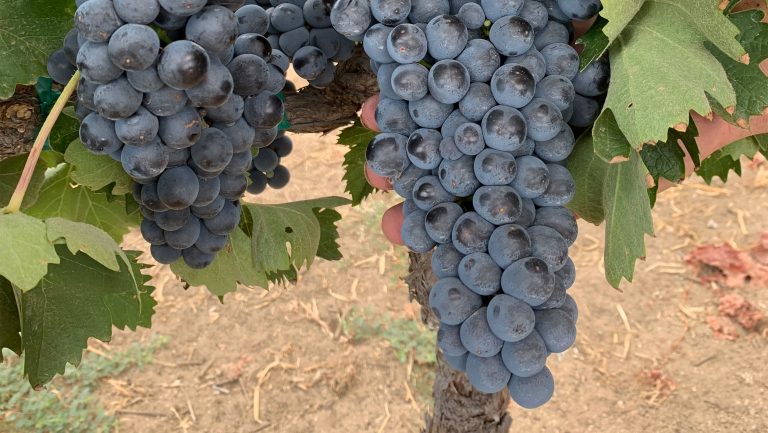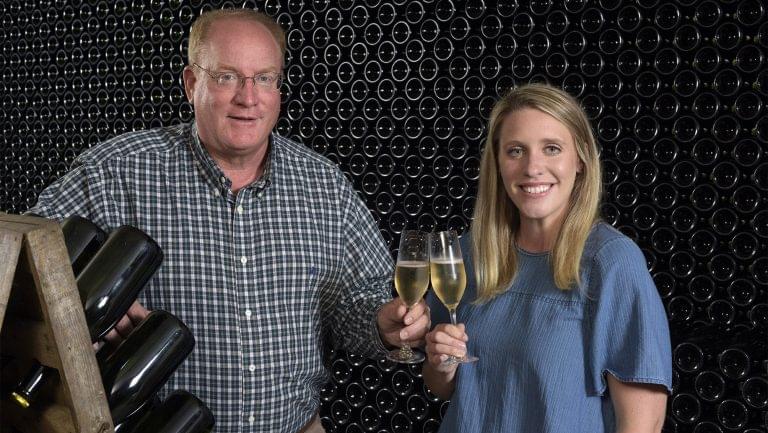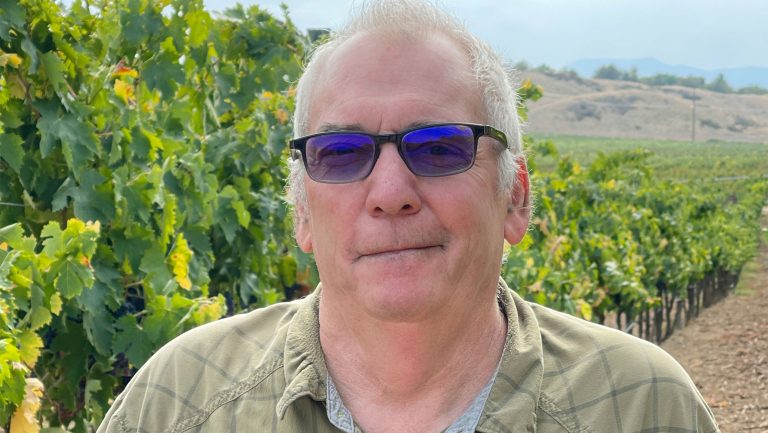Anyone making wine in the Willamette Valley knows that Pinot Noir is king. But since founding her winery in 2006, Remy Drabkin of Remy Wines in McMinnville has been focused on Lagrein, Dolcetto, and other grapes more typically associated with Alto Adige and Piedmont.
Growing and vinifying non-traditional local varieties such as these presents opportunities and challenges in both the vineyard and the sales market. Though Lagrein can be hard to ripen in the Willamette Valley’s cool climate, for instance, “[the clusters] are big and open, which means that air can come through,” says Drabkin. “That makes it naturally less susceptible to some of the mold and mildew issues we have here.” At its traditional home in the Dolomites, it’s exposed to extreme cold, heat, and humidity, so she expects the grape will do well as climate change advances.
Trying to market Oregon Lagrein or Dolcetto to distributors and retailers isn’t an easy task, either. But Drabkin sells most of her wine out of the tasting room, and she has no problem moving bottles. “I’ve worked for a long time to have a wine brand that people know they’re going to get a really good wine when they go,” she says. Her decision to differentiate has also brought interesting opportunities. Drabkin recently participated in a series of U.S. masterclasses sponsored by the Alto Adige Wine Consortium that discussed the impact of region on grapes such as Lagrein and looked at the many similarities between Alto Adige and Oregon.

Don’t miss the latest drinks industry news and insights. Sign up for our award-winning newsletters and get insider intel, resources, and trends delivered to your inbox every week.
Drabkin isn’t alone in her efforts to plant lesser-known local grapes from abroad into American vineyards; vintners from Washington to California and Texas to New York State are investing in under-the-radar grapes from Italy, Spain, Georgia, and beyond.
Viticultural Advantages and Winemaker Passions
Rudy Marchesi’s fascination with Lagrein and Teroldego dates to 1988, when he traveled to Italy and learned about the potential for the grapes of northern Italy to do well in Oregon. Montinore Estate, where he’s worked since 1998, has some warmer spots that seemed ideal for Lagrein. Teroldego, which thrives in cooler mountainous areas of Trentino, is a good match for Oregon’s climate.
Marchesi’s drive to craft wines other than Pinot Noir and Pinot Gris has several facets. “From a winemaker’s point of view, we like creativity. We like to do things that are fun, and it’s fun to try something different,” says Marchesi.

Marchesi also believes the nascent Willamette Valley wine industry would benefit from some diversity. Close to 99 percent of the red grapes planted in the Willamette Valley in 2020 were Pinot Noir, so “there’s a lot of room for exploration and doing something a little different,” he says. While there’s no denying that the Willamette Valley is a special place to grow Burgundy’s top red grape, “we’ve really limited ourselves in terms of our potential by focusing so heavily on Pinot Noir.”
When Rick Buffington moved to Temecula, California, to start Cougar Vineyard and Winery with his wife, he believed focusing on lesser-known varieties could be a winning formula for a winery. At the time, most people in Temecula were growing French grapes such as Syrah and Viognier. Buffington was more drawn to a friend’s estate in nearby Carlsbad, which was planted to 30 different grapes from Italy.
Cougar started with cuttings of Montepulciano from this estate, and over time, Buffington and his brother, who now owns an adjacent vineyard, have added plantings of varieties such as Aglianico, Brachetto, Negroamaro, and Ciliegiolo. (The last wasn’t yet approved by the Alcohol and Tobacco Tax and Trade Bureau when it was grafted over in 2017; Cougar had to go through the agency’s approval process to print the variety’s name on his labels.)
Their motivations were partly practical; some of these grapes are better adapted to Temecula’s hot climate. But some of it was personal. “I wanted to do something different,” says Buffington. “Growing the same thing as everyone else would be boring.”
Dr. Konstantin Frank Winery in the Finger Lakes region of New York is a champion for Saperavi and Rkatsiteli, two grapes barely known outside of Georgia until recently. Fred Frank, the winery’s third-generation owner, explained that when his grandfather first planted the vineyard in 1958, no one had successfully grown Vitis vinifera on the East Coast, so he put more than 60 varieties in the ground just to see what might grow. Saperavi and Rkatsiteli were among the ones that did well.

The winery expanded its plantings of the grapes “for viticulture reasons and quality reasons—less so for marketing reasons,” says Frank. “But we felt if the quality was there, the market would expand.” Over time, he has watched demand for Saperavi and Rkatsiteli grow among both wine drinkers and winemakers.
“Initially, our wine consumers were less adventuresome,” says Frank. “Twenty years ago, it was all about Chardonnay and Merlot and other varieties they could pronounce and were comfortable with. Consumers today are looking to try new things and expand their palates. That’s helped us from a marketing standpoint.”
Winemakers looking to create a deep red wine in cooler regions are fans of Saperavi because it’s a teinturier grape, which makes it easier to produce a wine that will stand out to consumers. Many in the natural wine movement have flocked to Rkatsiteli because it is traditionally made as a skin-contact wine in amphorae.
Maintaining Varietal Identity Away from Home
Because grapes like Aglianico and Rkatsiteli aren’t widely grown outside of their places of origin, it begs a question: Do these grapes—and the wines they produce—suffer when they’re planted elsewhere?
Just as Napa Cabernet Sauvignon made people believers in American wine and Malbec put Argentina on the international wine map—both grapes, remember, that originated in France, not the U.S.—these winemakers argue their grapes craft excellent wines even when planted far from home.
For four years, Buffington sponsored a dinner series called the Cougar Meets Italy Competition; in a blind tasting with six judges, five Cougar wines were paired against an Italian wine of the same variety. “We never got skunked,” says Buffington. “Four or five of our wines would beat the Italian wines each time. They taste very much the same. One time, an Italian somm on the judging panel pulled me aside and said, ‘I could tell the Italian varieties from your varieties, but for everyday drinking wine, I liked yours better.’”

Marchesi doesn’t believe his out-of-place grapes have lost their identity. “Our Lagrein tastes a lot like Lagrein from Alto Adige,” he says. Additionally, there’s no pressure to vinify the grapes in a singular way. “You’re starting from scratch because there’s no history and no one to consult with,” adds Marchesi. He and his team have made numerous different choices around maturation (using both barrels and amphorae), how much skin contact to allow, and whether to include stems over the 12 years the vines have been producing.
Sometimes the expression of a grape variety surprises and delights everyone when it’s grown in a new place. Dave Reilly, the winemaker at Duchman Family Winery in Driftwood, Texas, has been growing Aglianico since the early 2000s. In 2009, his distributor brought a group of Italian winemakers and importers for a visit. One came from southern Italy and was eager to try the Aglianico, even though it was relatively young. At some point, he asked through a translator, “How does it taste so good when it’s so young?”
Marketing Takes More Effort
International grapes like Pinot Noir and Sauvignon Blanc market themselves; these lesser-known grapes from abroad present more of a challenge. Many winemakers agree that having a tasting room, where staff members can educate guests on what they’re drinking, is key. “We started selling our wines to restaurants but it just wasn’t practical,” says Buffington. In that setting, people would hesitate to order something they’d never heard of. “Having a tasting room was important because if people can try it, they like it,” he adds.
Like Drabkin, Reilly says focusing on producing quality wine makes a big difference. “When the quality is there, it’s hard to argue. Even if people have never heard of it or can’t pronounce it, they still like the way it tastes,” he says. “With Montepulciano and Aglianico, we’re able to produce really great wines in the worst years and exceptional wines in the best years.”
That’s why it’s important to carefully consider how well-suited a new and unknown grape is to a particular vineyard when deciding whether to plant it. “Think really hard about whether they are going to work on your site,” advises Reilly, noting that winemakers should also consider whether they really want to work with those grapes in the winery.

Wine professionals play a critical role in bringing attention to wines made for unusual foreign varieties as well. “If you can get somms and writers excited about your varietal [sic], that makes a big difference,” says Reilly. “I don’t know if we would have had as much success with the Vermentino without them helping our brand.”
A couple of sommeliers have taken a liking to Frank’s Rkatsiteli and become ambassadors for the wine. “They’ll tell the story and the history of it, and they’ll taste the wines with their customers and make real believers out of them,” he says.
Even with some coaxing, it can be challenging to get people to take a chance on an unknown grape. But it’s fun too, Frank says. “You see a smile on their face when you’ve educated them about something new and they’ve found a new favorite wine.”

Dispatch
Sign up for our award-winning newsletter
Don’t miss the latest drinks industry news and insights—delivered to your inbox every week.
Sophia McDonald is a freelance writer who lives in Eugene, Oregon. Her work has appeared in numerous publications and on websites, including Wine Enthusiast, Eating Well, Sip Northwest, and 1859 Oregon’s Magazine.







